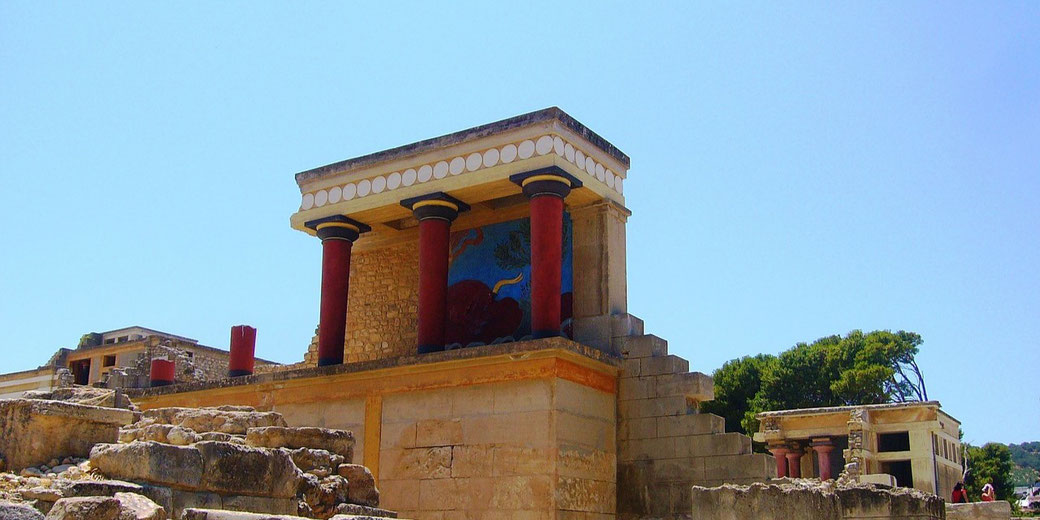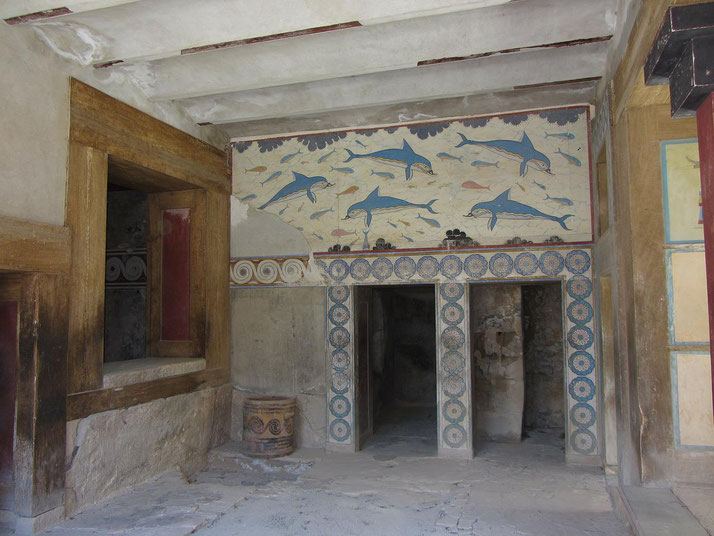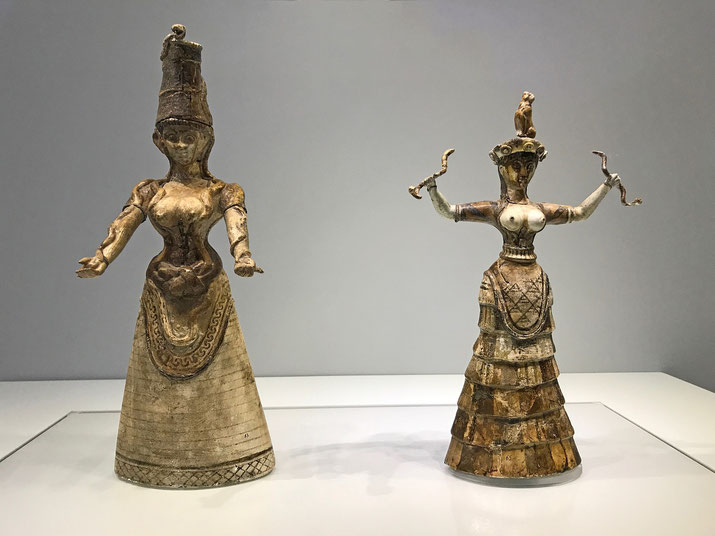Who were the Minoans and the Mycenaeans?

When people think about ancient Greece, they instantly picture the gleaming white marble of the Parthenon in Athens, or the legendary warriors of Sparta.
However, these come from the Classical Period of Greek history. What many people don't know is that Classical Greece was inspired by two much more ancient civilizations called the Minoans and the Mycenaeans.
These two cultures, that existed for more than a thousand years before, developed the key elements of language, writing, architecture, and religion, that would all become central to what it was to be 'Greek' in the ancient world.
But who exactly were the Minoans and Mycenaeans?
The Minoans
The Minoan civilisation was the first great Greek civilisation, and it flourished on the island of Crete between c. 2000 - c. 1500 BC.
This culture had been forgotten to history until the late 19th and early 20th centuries AD, when the archaeologist, Arthur Evans, rediscovered the ruins of their great city at Knossos, which sparked a wave of public interest in this mysterious civilisation.
Evans and other archaeologists named this culture the 'Minoans' after the legendary King Minos of Crete, who was said to have built the great labyrinth at Knossos.
The name 'Minoan' is now widely used to refer to both the civilisation and its architecture.
Minoan culture
The Minoans were believed to be a general peaceful people who appeared to have preferred making money rather than war.
The Minoans became a powerful and wealthy people who established extensive maritime trade networks across the Mediterranean.
Their influence reached as far as Egypt, the Levant, and possibly even Spain, as evidence of Minoan pottery and goods have been found in all of these locations.
As a result, they had well-developed systems of writing and mathematics.
In particular, the Minoan culture had a mysterious writing system called Linear A, which has still not deciphered.
They were also skilled artists, as evidenced by the many beautiful artefacts that have been found at Minoan sites.

Minoan architecture
The Minoans had a highly organised society, with a strong central government.
They were skilled architects and engineers. Their largest cities, such as the famous Knossos, centred around large palace structures.
Other large Minoan palaces were also found at Phaistos, Malia, and Zakros.
These massive structures appeared to be used for both administrative and religious purposes.
The palaces appear to have been built during two distinct eras. The first were built around 2000 BC, but then rebuilt again around 1700 BC.
The rebuilding seems to have taken place following severe earthquakes and fires.
These second palaces were destroyed again between 1500 to 1450 BC, when they were once again destroyed by earthquake, fire, or invasions.
The fact that Minoan cities did not appear to have any defensive walls suggests that they really were a relatively peaceful culture.
However, weapons such as swords, daggers, and arrowheads and defensive equipment such as armor and helmets have been found throughout Crete, which shows that they were not an entirely pacifist culture.

Minoan religion
One of the most distinctive aspects of Minoan culture was their religion. It appears to have revolved around worship of a female goddess.
This is reflected in their art, and often depicts women in positions of power and authority.
The most important deity was a goddess known as the Snake Goddess. This female deity was often depicted with animals, and she may have been an important fertility goddess.
Two small faience figurines were unearthed in 1903 by the British archaeologist Sir Arthur Evans at the palace of Knossos.
These probably depict this goddess herself, or maybe even the priestesses of her cult.

A particular animal that features heavily in religious art in the Minoan culture is the bull.
Bulls were likely associated with the same Minoan goddess. In particular, the act of 'bull-leaping' is a famous feature of Minoan culture, and it appears to have been a religious ritual in which participants would literally jump or flip over bulls as they ran.
This is quite a curious practice, and its meaning is still not clear. It may have been intended as a way to appease the gods.
Fall of the Minoans
The Minoan civilisation came to an end around 1450 BC. Archaeologists are still not sure what the cause of their collapse was. However, a few potential theories have been proposed.
One possible cause of the fall of the Minoans may have been the invasion of the island of Crete by the rising Mycenaean culture on the Greek mainland.
This may have been due to political or economic instability.
Another potential cause may have been the Thera eruption, which was one of the largest volcanic eruptions in history.
This eruption is estimated to have occurred around 1500 or 1200 BC. It would have had a devastating effect on the Minoan civilisation, as it would have caused widespread damage and destruction.
The final theory for their collapse may have been internal social conflict.
There is evidence that there was considerable social unrest in the later years of the Minoan civilisation.
Such disruption may have led to civil war, which could have further contributed to their demise.
In reality, it may have actually been a combination of all of these causes which brought about the end of the Minoan civilization.
However, even after their collapse, the Minoan culture continued to influence other people groups.

The Mycenaeans
The Mycenaean civilisation arose in mainland Greece c. 1600 BC, and it lasted until c. 1100 BC.
This was a turbulent period in Greek history, which saw frequent wars between the various city-states.
The Mycenaeans were clearly influenced by the earlier Minoan civilisation, as much of their initial art styles, architecture and language were based upon Minoan examples.
The Mycenaeans were named after their largest city, Mycenae. In a similar way to the Minoans, this culture had also been largely forgotten until the 19th century AD, when the archaeologist, Heinrich Schliemann, excavated the site of Mycenae in 1876.
Schliemann used the ancient Greek poems of the Iliad and the Odyssey by Homer to identify potential archaeological sites.
In Homer's works, the city of Mycenae was described as being a wealthy and powerful city.
Other well-known Mycenaean sites include Pylos, Tiryns, and Sparta.
Mycenaean culture
The different Mycenaean cities seem to have operated independently. However, there are several shared cultural characteristics among sites that make the term Mycenaean meaningful.
Some of the most distinctive features of Mycenaean culture include their art, architecture, and writing system.
The Mycenaeans were skilled craftsmen, and they produced a wide range of artworks in precious metals, as well as fine pottery and jewelry.
The art from this culture is defined by its realism and its use of bright colours.
Also, the Mycenaeans adapted the Minoan writing system of Linear A into their own writing system called Linear B.
This script was used for mostly for administrative purposes, and it has been found at sites such as Pylos and Mycenae.
In a ground-breaking moment, Linear B was deciphered in 1952 by the English architect, Michael Ventris.
He discovered that it was the earliest form of the ancient Greek language.
Mycenaean architecture
One of the most distinctive features of Mycenaean culture is their architecture.
Mycenaean buildings were constructed on a large scale and relied heavily on stone. This is still seen today in their elaborate fortifications around their cities.
Like the Minoans, Mycenaean palaces were typically large complexes that included a main building, which was a large rectangular central hall, called a megaron.
These complexes also had several ancillary structures attached to them. These palaces were used as the residences of the Mycenaean elite, and they also served as administrative centres.
Consequently, Mycenaean fortifications are some of the most impressive examples of ancient architecture.
They built incredibly huge walls to protect their cities, which used large stones that fitted together without mortar.
Some Mycenaean walls were as high as 13 metres.
The most famous example of Mycenaean fortifications is the Lion Gate at Mycenae.

Mycenaean society
Mycenaean society was organised into a hierarchy, with a king at the top, known as the wanax.
The king was then advised by a council of nobles. Each noble controlled an army of soldiers that could be called upon to serve the wanax.
It seems that the Mycenaeans were a warrior culture, and they were known for their skill in battle.
They frequently engaged in warfare with the neighbouring peoples, including those in Asia Minor.
Perhaps their most famous conflict is remembered in the mythology of the Trojan War, which was said to have been fought between the Mycenaeans and the Trojans.
At its height, he Mycenaeans were a wealthy civilisation, with access to valuable resources like gold and tin.
However, this wealth was primarily spent on military features of their cities.

Mycenaean trade
The Mycenaeans were a maritime people, and they engaged in trade with other cultures.
Initially, the Mycenaeans traded with the Minoans, but later would make economic exchanges with the Egyptians and the Assyrians.
This explains why Mycenaean trade goods have been found as far away as Egypt, Mesopotamia, the Middle East, Turkey, and the island of Sicily.
In a similar system to the Minoans, Mycenaean trade was facilitated by their network of palaces.
Also, the Mycenaeans also built a system of roads that connected their different cities and to expand their trading network.
Mycenaean religion
One of the most interesting parts of the Mycenaean culture is that they practised a form of religion that was based on the worship of natural forces.
They believed in gods and goddesses who represented these forces, such as the sun god and the earth goddess.
Many of the later Greek gods appeared to have originated from the Mycenaean period, including Zeus, Poseidon, and Hades.
In addition, the Mycenaeans practised animal sacrifice, and they believed that this would please the gods and ensure their favour.
Animal remains have been found at several Mycenaean sites, including Pylos, Mycenae, and Tiryns.
However, our knowledge of Mycenaean religion is limited and based largely on archaeological evidence and the decipherment of Linear B.
They buried their dead in shaft graves, which were large burial pits. The bodies were placed in these graves along with grave goods, such as pottery and jewelry.
For the wealthiest in Mycenaean society, they could large tombs known as tholos tombs.
Fall of the Mycenaeans
The Mycenaean civilisation began to decline in the late Bronze Age and collapsed around 1200 BC.
Again, the exact causes of this are not well understood. There are a number of theories, but it is likely that a combination of factors was responsible, including natural disasters, invasion, economic instability, social unrest, and environmental problems.
One of the most popular traditional theories is known as the 'Dorian Invasion'.
This suggests that the Mycenaeans were invaded and conquered by the Dorians, a group of people from the north.
However, modern historians doubt the accuracy of this theory.
Whatever the reasons for its decline, the Mycenaean civilisation came to a rapid and dramatic end.
After its disappearance, Greece entered a period known as the 'Dark Age', which lasted for around 500 years.
During this time, very little is known about Greece or its people since written records do not survive.
Further reading
What do you need help with?
Download ready-to-use digital learning resources
Copyright © History Skills 2014-2025.
Contact via email
With the exception of links to external sites, some historical sources and extracts from specific publications, all content on this website is copyrighted by History Skills. This content may not be copied, republished or redistributed without written permission from the website creator. Please use the Contact page to obtain relevant permission.





